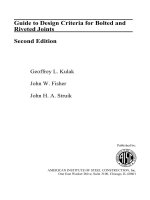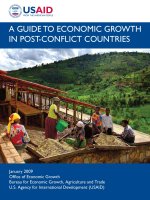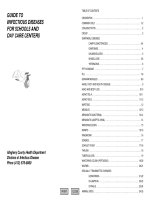A guide to economic startistics for practitioners and students
Bạn đang xem bản rút gọn của tài liệu. Xem và tải ngay bản đầy đủ của tài liệu tại đây (12.37 MB, 462 trang )
1
ForothertitlesintheWileyFinanceseries
pleaseseewww.wiley.com/finance
2
Trading Economics
A Guide to Economic Statistics
for Practitioners and Students
TrevorWilliams
VictoriaTurton
3
Thiseditionfirstpublished2014
©2014TrevorWilliamsandVictoriaTurton
Registeredoffice
JohnWiley&SonsLtd,TheAtrium,SouthernGate,Chichester,WestSussex,
PO198SQ,UnitedKingdom
Fordetailsofourglobaleditorialoffices,forcustomerservicesandfor
informationabouthowtoapplyforpermissiontoreusethecopyrightmaterial
inthisbookpleaseseeourwebsiteatwww.wiley.com.
Allrightsreserved.Nopartofthispublicationmaybereproduced,storedina
retrievalsystem,ortransmitted,inanyformorbyanymeans,electronic,
mechanical,photocopying,recordingorotherwise,exceptaspermittedbythe
UKCopyright,DesignsandPatentsAct1988,withoutthepriorpermissionof
thepublisher.
Wileypublishesinavarietyofprintandelectronicformatsandbyprint-ondemand.Somematerialincludedwithstandardprintversionsofthisbook
maynotbeincludedine-booksorinprint-on-demand.Ifthisbookrefersto
mediasuchasaCDorDVDthatisnotincludedintheversionyoupurchased,
youmaydownloadthismaterialat.Formore
informationaboutWileyproducts,visitwww.wiley.com.
Designationsusedbycompaniestodistinguishtheirproductsareoften
claimedastrademarks.Allbrandnamesandproductnamesusedinthisbook
aretradenames,servicemarks,trademarksorregisteredtrademarksoftheir
respectiveowners.Thepublisherisnotassociatedwithanyproductorvendor
mentionedinthisbook.
LimitofLiability/DisclaimerofWarranty:Whilethepublisherandauthor
haveusedtheirbesteffortsinpreparingthisbook,theymakeno
representationsorwarrantieswiththerespecttotheaccuracyorcompleteness
ofthecontentsofthisbookandspecificallydisclaimanyimpliedwarrantiesof
merchantabilityorfitnessforaparticularpurpose.Itissoldonthe
understandingthatthepublisherisnotengagedinrenderingprofessional
servicesandneitherthepublishernortheauthorshallbeliablefordamages
arisingherefrom.Ifprofessionaladviceorotherexpertassistanceisrequired,
theservicesofacompetentprofessionalshouldbesought.
LibraryofCongressCataloging-in-PublicationData
4
Williams,Trevor,1957–
Tradingeconomics:aguidetoeconomicstatisticsforpractitioners&
students/TrevorWilliams,VictoriaTurton.—1
pagescm.—(TheWileyfinanceseries)
Includesbibliographicalreferencesandindex.
ISBN978-1-118-76641-5(hardback)—ISBN978-1-118-76631-6(ebk)—
ISBN978-1-118-76638-5(ebk)—ISBN978-1-118-76629-3(ebk)1.Finance—
Statistics.2.Moneymarket—Handbooks,manuals,etc.I.Turton,Victoria,
1974–II.Title.
HG176.5.W552014
330.01′5195—dc23
2014007150
AcataloguerecordforthisbookisavailablefromtheBritishLibrary.
ISBN978-1-118-76641-5(hardback)ISBN978-1-118-76631-6(ebk)
ISBN978-1-118-76638-5(ebk)ISBN978-1-118-76629-3(ebk)
Coverimage:Shutterstock.com
5
CONTENTS
Acknowledgements
Introduction
SurpriseIndices
MappingaNewLandscape
Note
1Surveys
SurveysandBehaviouralEconomics
TypesofSurvey
BusinessSurveys
ConsumerSurveys
Conclusion
Notes
2EconomicGrowth
EconomicGrowthThroughtheAges
GDP
WhatisGDP?
BreakingDownGDP
WhyisGDPimportant?HowisItMeasured?
IndexNumbersofGDPandthePriceDeflators
UsedinCalculatingThem
DetailedBreakdownoftheGDPMeasures
AMarketLink
ComponentsofGDP
Conclusion
6
Notes
3LabourMarkets
EmploymentTrends
WhathasDriventheChange?
ConsequencesforEconomicGrowth
PhillipsCurveShowsnoDurableTrade-OffExists
NAIRUMattersMore
EmploymentMeasures
WhyWeMeasureUnemployment
TheNatureofUnemployment
TheImpactofDemographicsonLabourMarkets
Vacancies
ChangingLabourPatterns
TheUKinComparisontoItsGlobalCompetitors
HowdoWeExtractValuefromThis?
Conclusion
Notes
4Inflation
WhatisInflation?
TheHistoryofInflation
CausesofInflation
Earnings/WageInflation
PriceBasket
HowisPriceInflationMeasured?
GDPDeflator
7
WhysoManyMeasuresofInflation?
AFocusontheCPIandRPI
WhyisInflationImportant?
Deflation
OtherMeasuresofInflationTargeting
HowcanWeExtractValuefromThis?
Conclusion
Notes
5MonetaryStatistics
MonetaryPolicyandInflationManagement
TheUKinaGlobalContext
CentralBank'sRole
WhatAbouttheBankofEngland?
HowMonetaryPolicyWorksintheUk
DecompositionofMoney
WhydoesMoneySupplyMatter?
WhyIsThisSortofAnalysisUseful?
ABriefHistoryofMonetaryTargeting
HowDoWeExtractValuefromThis?
Conclusion
Notes
6FiscalIndicators
ABriefHistoryofUKFiscalPolicy
MeasuringGovernmentDebt
FiscalPolicyImpactandTerminology
8
TheImpactofGovernmentonMarkets
FiscalPolicyandGrowth
TheDataWeShouldConsider
FiscalPolicyinBoomandBust
MarketRelevance
BankofEnglandRegainsRegulatoryPowers
WhatRoleDoestheOfficeforBudget
ResponsibilityPlayintheFiscalPolicyProcess?
TheMonetaryPolicyCommittee
ForwardGuidance–AnotherBankInnovation
TheDebtManagementOffice'sRole
ComparisonofInternationalDebt
FiscalTargetsAddCredibilitytoDebtReduction
HowCanWeExtractValuefromThis?
Conclusion
Notes
7GlobalTradeStatistics
WhatIsaCountry'sBalanceofPayments?
WhyDoWeMeasuretheBalanceofPayments?
WhatDoesItMean?
TheConceptoftheBalanceofPayments
UKIsnotAloneinHavingaTradeDeficit
AChronicGoodsDeficit
AChronicServicesSurplustoOffset(Almost)the
TradeDeficit
9
TheEver-ChangingPatternofVisibleandInvisible
Trade
BalanceofPaymentsandGDP
ShiftingTradePatterns
HowCanWeExtractValuefromThis?
Conclusion
Notes
Conclusion
Beanchoredtothedataflow
Somekeypointstotakeaway
Note
Appendices
Appendix1Surveys
CBIIndustrialTrendsSurvey
CBIDistributiveTradesSurvey
Notes
Appendix2BankofEngland:Agents'Summaryof
BusinessConditions(January2014)
Appendix3Inflation:ContributionstoChangein
the12-MonthRate
Appendix4VotingonInterestRatesbythe
MonetaryPolicyCommittee–1997toJanuary
2014
Appendix5VotingonAssetPurchasesFinanced
withcentralbankreservesbytheMonetaryPolicy
Committee–March2009toJanuary2014
10
Bibliography
Index
EndUserLicenseAgreement
List of Tables
Chapter2
Table2.1
Table2.2
Table2.3
Table2.4
Table2.5
Table2.6
Table2.7
Table2.8
Table2.9
Chapter3
Table3.1
Table3.18
Table3.19
Chapter4
Table4.1
Table4.2
11
Table4.3
Table4.4
Chapter6
Table6.1
Table6.2
Chapter7
Table7.1
Table7.2
Table7.3
List of Illustrations
Chapter1
Figure1.1UKequitypricesriseasPMI'ssuggesta
strongeconomicrecoveryisunderway.
Figure1.2BondyieldsriseasPMI'ssuggesta
strongeconomicrecoveryisunderway.
Figure1.3SterlingrisesvsUS$asPMI'ssuggesta
strongeconomicrecoveryisunderway.
Figure1.4Sterlingrisesvseuroasmarketthinks
interestratesmayriseasgrowthpicksup.
Figure1.5RegionalUKeconomicactivity–PMI
balances.
Figure1.6CBIconfidencemeasurevsFTSE.
12
Figure1.7Confidencevsinvestmentspending.
Figure1.8Confidencevsmanufacturingoutput.
Figure1.9Businessconfidenceleadssterlingvs
theUSdollar.
Figure1.10UKbusinessandconsumer
confidence.
Figure1.11LloydsBankBusinessBarometer
measuresfirms'confidenceagainstthe
performanceoftheFTSEAll-Share.
Figure1.12UKtrade-weightedexchangeratevs
BusinessBarometer.
Chapter2
Figure2.1Theworlduntil2000.2
Figure2.2AnnualGDPintheUKoverthepast50
years.
Figure2.3GlobalGDPgrowth(percent;quarter
overquarter,annualised).
Figure2.4Outputindicesbysector,UK.
Figure2.5UKchartbydifferentmeasures.
Figure2.6SummaryofstatisticsforQ42012
quarter-on-quartergrowth.GVA,grossvalueadded;
CVM,chainedvolumemeasure;CP,currentprices;
SA,seasonallyadjusted.
Figure2.7Grossoperatingsurplusof
corporations,%growth,quarteronquarter.
13
Figure2.8Compensationofemployees,%
growth,quarteronquarter.
Figure2.9Manufacturinggrowth,%quarteron
quarter.
Figure2.10Servicesgrowth,%quarteron
quarter.
Figure2.11Householdfinalconsumption
expendituregrowth.
Figure2.12Grossfixedcapitalformationgrowth,
quarteronquarter.
Figure2.13Nettrade,£(billion).
Figure2.14Netlendingbysector(percentageof
GDP).PNFC,privatenonfinancialcompanies,
FINCO,financialcompanies,NPISH,non-profit
institutionsservinghousehold.
Figure2.15TheUKsavingratiohasnowrisen
afterfallingtozero.
Figure2.16UKhouseholddebtratiohasfallen,
buthasitfallenfarenough?
Figure2.17UKGDPdoeshaveagoodlinkwith
shareprices.
Chapter3
Figure3.1UKunemploymentrate(aged>16
years),seasonallyadjusted.
Figure3.2UKemploymentrisesevenasGDP
growthstaysflat,implyingfallingproductivity.
14
Figure3.3Changesinemploymentsince2008.
Figure3.4Earningsgrowthincomparisonwith
priceinflation.
Figure3.5Nolinkbetweenunemploymentand
wageinflationovertime?
Figure3.6TheNAIRUsuggestthattheinflation
backdropisbenign.
Figure3.7UKlabourmarket.
Figure3.8Lengthofunemployment–period
endingFebruary2013.
Figure3.9Lengthofunemployment–
comparisonbetweenFebruary2003andFebruary
2013.
Figure3.10Longer-termdemographictrendsin
theUK,byage.
Figure3.11Working-agepopulation.
Figure3.12Growthslowingrapidlyinworkingagepopulation.
Figure3.13Unemploymentratebyage.
Figure3.14Youngpeopleinthelabourmarket.
Figure3.15Summaryoflabourmarketstatistics,
April2013.
Figure3.16Numberofclaimants(excluding
clericalclaims)byageandsexforMarch2013,
seasonallyadjusted.
15
Figure3.17Unemploymentratebygender.
Figure3.20Howtheinactivitynumbersbreak
down.
Figure3.21Economicinactivityrate(aged16–
64),seasonallyadjusted.
Figure3.22UKlabourparticipationrate.
Figure3.23UKvacancies.
Figure3.24Employmentgrowthbyoccupation.
Figure3.25Employmentstatisticsbysector.
Figure3.26Publicsectoremploymentbyindustry
forDecember2012,seasonallyadjusted.
Figure3.27Hoursworked.
Figure3.28Unitlabourcostsandproductivity
(outputperworker).
Figure3.29Unemploymentratebyregion,
February2013.
Figure3.30UKunemploymenttrendssince
2000.
Figure3.31UKharmonisedunemploymentrate
in2011.
Chapter4
Figure4.1Priceindexovertime.
Figure4.2AhistoryoftheincreaseinRPI.
Figure4.3Changesingoodspricesexplainoverall
16
UKpriceinflation.
Figure4.4UKimportpricesvsgoodsprice
inflation.
Figure4.5UKCPIvsforeignexchangerate.
Figure4.6Cost-pushinflationasaresultofOPEC
increasingitsprices10-foldinthe1970s.AD,
aggregatedemand;AS,aggregatesupply;Y,real
output.
Figure4.7Demand-pullinflation–ariseswhen
aggregatedemandinaneconomyoutpaces
aggregatesupply.AD,aggregatedemand;AS,
aggregatesupply;Y,realoutput.
Figure4.8Averageearningsandconsumerprices
annualgrowthrates.
Figure4.9GDPdeflatorshowingpercentage
increaseinayear.
Figure4.10Factorygateoutputpriceinflation.
Figure4.11Factoryinputpriceinflation.
Figure4.12DifferencebetweenRPIandRPIJ,
percentageyearonyear.
Figure4.13GapwedgebetweenCPIandRPI.
Figure4.14InflationagainsttheBankof
England'sinflationtarget.
Chapter5
Figure5.1Long-termtrendsinbroadmoney
17
growth.
Figure5.2Thevelocityofmoney.
Figure5.3August2013CPIfanchart,basedon
constantnominalinterestrates.4
Figure5.4August2013GDPfanchart,basedon
constantinterestrates.55
Figure5.5Selectionofcentralbankpolicies.
Figure5.6Assetpricesandmoneysupply.
Figure5.7Moneysupplyandhouseprices.
Figure5.8UKmonetarypolicyistheloosestinits
history.
Figure5.9QEtransmissionchannels.
Figure5.10Velocityofbroadmoney(ratioof
nominalspendingtonominalbroadmoney
holdings).
Figure5.11M4extrendsince2007.
Figure5.12UKliabilitiesandassetsofthe
bankingsector.
Figure5.13Counterpartstobroadmoneygrowth
M4.
Figure5.14TheimpactofQEonthesizeofthe
UKcentralbankbalancesheet.
Figure5.15Quantitativeeasinghashadlittle
impactonUKgrowth.
18
Figure5.16Interestratesandinflation.
Figure5.17M4andinflation.
Figure5.18Thelonger-termrelationbetweenCPI
andM4.
Figure5.19UKM4broad(adjusted)vsnarrow
moneyM0.
Figure5.20NominalGDPgrowthisanalogousto
broadM4moneysupply.
Figure5.21Twelve-monthpercentagegrowthin
M4depositsbysector.
Figure5.22Twelve-monthpercentageincreasein
M4lendingbysector.
Figure5.23Thevalueofdepositsandlendingin
theUKoverthe2012–13.
Figure5.24M4andUKeconomicgrowth.
Chapter6
Figure6.1AhistoryofUKdebtfrom1692to2011
(publicsectornetdebt).
Figure6.2UKdebthasrisensharplysince2000.
Figure6.3RealGDPgrowthvsgovernmentdebt
toGDPratio.Higherdebtratio,slowergrowth.
Figure6.4NewregulatoryframeworkattheBank
ofEngland.FPC,FinancialPolicyCommittee;FCA,
FinancialConductAuthority;PRA,Prudential
RegulationAuthority.g
19
Figure6.5Majorstatutorydecision-making
responsibilitiesoftheBankofEngland.Forfurther
detailontheSpecialResolutionRegime,see
www.bankofengland.co.uk/financialstability/Pages/role/
www.hmtreasury.gov.uk/d/fin_fs_bill_mou_financial_crisis_ma
Figure6.6MembershipoftheBankofEngland
bodies.
Figure6.7UKinterestpaymentsonthe
governmentdebt.
Figure6.8UKdebthasmovedupsharplybutis
stillbeloweuroaverage.
Figure6.9UKupthedebtranking?
Figure6.10UKgovernmentdebtcomparedwith
othercountries.
Figure6.11UKbudgetdeficitwillimproveonly
slowly.
Figure6.12Itwillbehardtocutgovernment
spending.
Chapter7
Figure7.1ExportsandimportsasashareofUK
GDP.
Figure7.2UKcurrentaccountbalanceasaper
centofGDP.
Figure7.3UKtradeinservicesandgoods.
Figure7.4Investmentincome:creditslessdebits.
20
Figure7.5Currentaccountdeficits
internationally.
Figure7.6UKexternaldeficitwidensfurtherin
2012.
Figure7.7Achronicdeficitistradeingoodsbuta
surplusinservices.
Figure7.8Changesininvestment.
Figure7.9Thetransfersdeficitworsened.
Figure7.10Thesurplusonthefinancialaccount
isnecessarytofundtheUK'scurrentaccount
deficit.
Figure7.11Astructuraldeficitingoodsisnot
quiteoffsetbyastructuralsurplusinservices.
Figure7.12UKtradepositionbyregion–Europe
ourbiggestmarket.
Figure7.13UKexportsbycountry(percent).
Figure7.14UKvisibleexportsbycountry
(£billion).
Figure7.15UKvisiblegoodsimportshares(per
cent).
Figure7.16UKvisiblegoodsimportshares
(£billion).
Figure7.17UKvisiblegoodsexports.
Figure7.18UKserviceexports.
Figure7.19UKexchangerate–doesitneedto
21
weakentohelpexports?
Chapterfintro
FigureI.1USdatasurprisevsUSequities.
FigureI.2JapanesedatasurprisevsJapanese
equities.
FigureI.3G10datasurprisevsJapaneseequities.
FigureI.4G10datasurprisevsUKequities.
FigureI.5UKdatasurprisevsUKequities.
FigureI.6ChinesedatasurprisevsChinese
equities.
FigureI.7G10datasurprisevsChineseequities.
FigureI.8USinflationsurprisevs10-year
nominalyields.
FigureI.9USinflationsurprisevs10-yearbreakevenrate.
Chapterp05
FigureA5.1UKbankratesince1694anditwould
gobelowthevotingrecordMarch2009toJanuary
2014.
22
Acknowledgements
Thankyoutoallofthepeopleinvolvedinwritingand
producingTradingEconomics.Specialthanksmustgoto
friendsandfamily.Withoutyourenduringsupport,this
journeywouldhavebeenfarmoredifficult.
June2013
23
Introduction
Today'sinterconnectedworld,linkedbyfreertrade,by
someofthegreatestmovementsofpeoplethrough
tourismandimmigrationtheworldhaseverseen,bythe
movementofgoodsandservices–allunderpinnedby
newmethodsofopencommunicationthatwere
unimaginableagenerationorsoagoandinvolvingmore
countriesthaneverbefore–meansthatanunderstanding
ofeconomicsmattersmorethanever.Itisnosurprise,
therefore,thatheadlinesscreameconomicnews,
newspapersarefullofstoriesbasedonstatisticsabout
economicperformancewithinandamongstcountries,
governmentofficialsareconstantlydiscussingthe
economyandtherearepundits,radioandTVshows,some
broadcasting24hoursaday,with‘experts’claimingto
knowallsortsofthingsbasedoneconomicdata.Then
therearealltheblogs,tweetsandinternetmediachannels
toaddtothemixture.Withthecacophonyofnoisefrom
thesemedia,itisincreasinglyhardtodiscernthe
underlyingeconomictrendsfromwhatareoften
conflictingdata.
Whathasallowedtoday'sworldtocomeintobeingisa
beliefthatmoretradeisbetterthanlesstrade,that
producinggoodsandserviceswhereitischeapesttodoso
allowsforariseinlivingstandardsforallconcerned
(thoughnotalltothesameextent).Thisoutcomeisbased
ononeofthefundamentalelementsofeconomic
rationale–thedivisionoflabourandcomparativetrade
advantage.Whatiseconomicsabout,ifnottheproduction
ofgoodsandservicestosatisfyhumanwantsandneeds?
24
Itistheacceptanceofthisnotionacrossmanysocieties
aroundtheworldthathasgivenrisetotheexplosive
increaseinglobalwealththathastakenplaceinthelast
50yearsandthatweseeallaroundus.
Thisiswhyanunderstandingofeconomicstatisticsand
whattheymeaniscrucial.Thesestatisticsarethebasis
forindividual,corporateandcollectiveorsocietal
decision-making.Governmentsuseeconomicstatisticsto
planspendingandpolicy;companiesusethemtodecide
whenandwheretoproducegoodsandservices;investors
(includingpensionfunds,insurancecompanies,
individualsetc.)usethemtodecidewheretoputtheir
wealth;andhouseholdsusethemtodecidewhentobuy
orsellgoodsandservices.
Thesedatadrivetrendsinthefinancialmarkets.Without
theconstantdripfeedofeconomicnews,marketstendto
drift.Whattheyawait–whattheyinfactneed–isthe
nextpieceofnewinformationtojoltthemintoaction.
Theexperienceofrecentyearshastaughtusthatfinancial
marketsdonotinhabitaseparaterealm,detachedfrom
the‘realeconomy’.Farfromit–financialmarketsare
fundamentallytetheredtotherealeconomy.Theyhavean
impactonusall.Thatiswhytheymatterandwhy
understandingthedatathatdrivesthefinancialmarkets
willsupporttradersandpractitionersinreadingthe
marketsmorecomprehensivelyandframingtheirown
reactionsaccordingly.
SURPRISE INDICES
25









